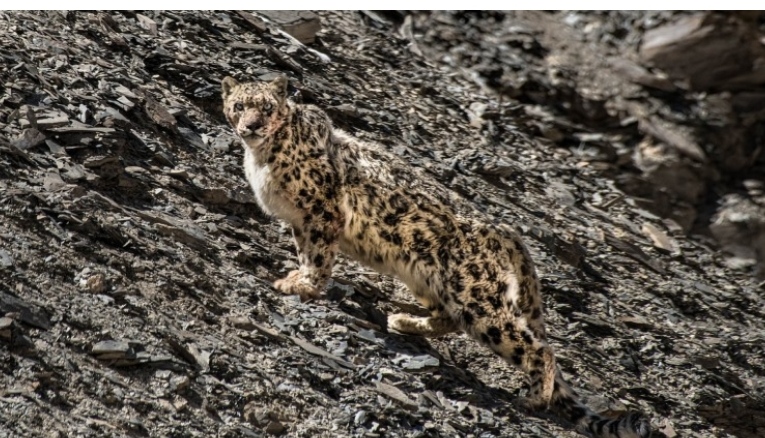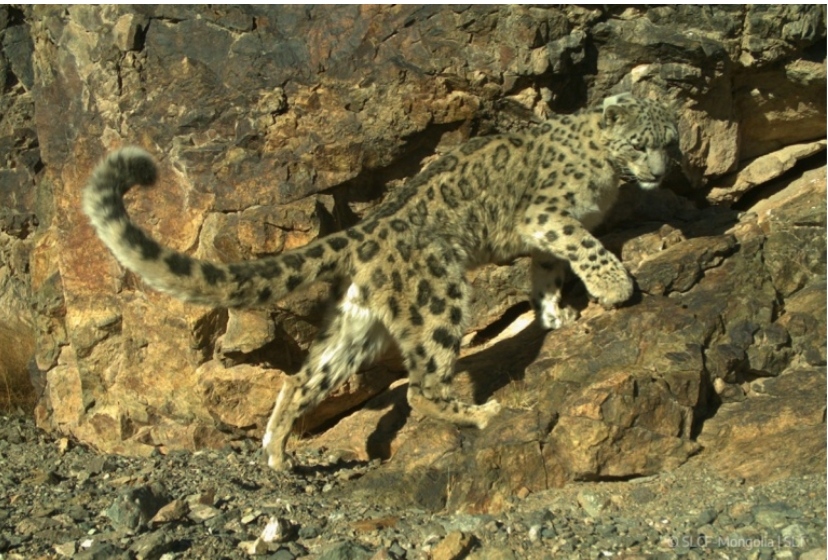Landmark studies bring elusive snow leopards back into limelight
Two large-scale studies concluded earlier this year unveil robust scientific data on the animal’s population for the first time.

Snow leopard in Hemis National Park, Ladakh, India
Marco Ferrarese
Ladakh, India – At the end of 1973, after two months spent roaming the wild Dolpo region in the Tibetan Plateau, American naturalist and writer Peter Matthiessen realised it was time to hang up his blood-soaked boots.
Exhausted, he abandoned zoologist George Schaller alone in the mountains, giving up his dream of seeing a snow leopard (Panthera uncia) in the wild.
Matthiessen wrote the story of that gruelling expedition in 1978 in The Snow Leopard, capturing the world’s imagination at a time when scientists still knew next to nothing about these elusive creatures.

Snow leopard in Hemis National Park, Ladakh, India
The harshness and sheer vastness of the snow leopard’s high-altitude environment – which stretches across 12 countries at the very centre of Asia, comprising some of the highest mountain ranges and plateaux in the world – is forbidding for both humans and technology.
But after more than 40 years of continuous research and innovation, studying snow leopards has become a less overwhelming task. Thanks to extensive camera trapping, two large-scale environmental studies earlier this year unveiled robust scientific data on the snow leopard population for the very first time.
Landmark developments
“We now have over a decade’s worth of data gathered from our Long-Term Ecological Study in Mongolia’s South Gobi, along with more reliable population estimates from many different parts of the range,” Marissa B Niranjan, the deputy director of the Seattle-based Snow Leopard Trust, told Al Jazeera.

A snow leopard stalking blue sheep at Hemis National Park, Ladakh
Founded in 1981 by Seattle’s Woodland Park Zoo’s then curator of education, Helen Freeman, the Trust celebrated 40 years of existence on January 28, 2021. It is the largest and oldest non-profit organisation to support snow leopard conservation, research and education by fostering local community partnerships in the animal’s habitats.
Niranjan refers to a first of its kind, three-year survey completed in February in the northern Indian state of Himachal Pradesh, which estimated the presence of up to 73 wild snow leopards there.
Conducted by the Snow Leopard Trust’s India team, along with the state’s forest department, Himachal Pradesh’s snow leopard survey was part of the Population Assessment of the World’s Snow Leopards (PAWS) programme.

Camera trap image of a snow leopard captured in the South Gobi region of Mongolia
Formally endorsed in 2017 in Bishkek, Kyrgyzstan, by the 12 countries that have snow leopards, PAWS aims to produce a robust estimate of its global population within the next five years.
At the end of March 2021, a second PAWS-related milestone study assessed preliminary snow leopard populations for the whole of Mongolia, with early results indicating the presence of nearly 1,000 cats – the world’s second-largest population after China.
“Until now, population figures tended to be best guesses. The new figures from various countries, using scientifically standardised techniques under PAWS, will add up to provide a reliable global estimate of the snow leopard population for the first time,” Charudutt Mishra, the executive director of the Snow Leopard Trust, told Al Jazeera.

A blue sheep, snow leopards’ traditional prey. Overgrazing by human-owned herds has reduced their numbers, pushing snow leopards to prey on corrals
Mishra added that such efforts were also enabling new conservation partnerships with communities and governments in countries having snow leopards.
“These rigorous studies at large spatial scales depend on strong local capacity, implying that considerable capacity enhancement is now taking place at local levels,” he said.
Snow leopards at risk
The latest scientific milestones have rekindled interest in the snow leopard, which remains “vulnerable” on the International Union for the Conservation of Nature Red List of Threatened Species.
According to the Snow Leopard Trust, it is reckoned that there are between 3,900 and 6,400 wild snow leopards left around the world, though the actual number remains unknown.
Some risks are well established. “Traditional threats include retaliatory killing because of their livestock predation behaviour, hunting of snow leopards and their prey, and overgrazing of pastures in certain situations,” Mishra told to Al Jazeera.
But others have surfaced relatively recently. As Mishra noted, “New and emerging threats include large-scale degradation due to mining and other developmental activities in snow leopard habitats, the threat of disease and warming of their habitats, and intensifying poaching and illegal trade of their body parts.”

A snow leopard in Ladakh, India
For some, the most pressing issue remains the coexistence and conflict between remote communities and snow leopards.
If they enter a shepherd’s corral, “a villager can lose all of their sheep in one go, which leads to a loss of income and anger and retaliation toward the leopard”, reports the website of the High Asia Habitat Fund, a US-registered organisation that promotes conservation through the empowerment of dependent communities in snow leopard territory.
Livestock predation accounts for the killing of 220 to 450 snow leopards each year. “With levels of conflict continuing to rise, what matters far more [than population numbers] are local people’s perceptions around snow leopards, and their willingness to tolerate the presence of this apex predator,” Professor Rodney Jackson told Al Jazeera.
A leading expert on snow leopards and their habitat, Jackson was the first to radio-collar snow leopards in remote western Nepal in the early 1980s in order to study their behaviour and population. He founded the Snow Leopard Conservancy in Sonoma, California, in 2000.
“The most pressing priority for conservationists must rest with immediate communication and the full participation of villages towards implementing solutions for preventing, or at least reducing, livestock depredation while simultaneously enhancing livelihoods opportunities,” said Jackson.

View of Rangdum village in the Zanskar region of Ladakh, India
Lack of tourism
Prior to the travel bans brought on by the COVID-19 pandemic, snow leopard-focused tourism constituted an important opportunity to help manage the conflict between the animals and humans in key locations such as Hemis National Park in the northern Indian territory of Ladakh.
“Snow leopard expeditions generate a lot of primary livelihoods for trackers, drivers, camp staff, cooks, porters, etc. They also generate secondary and tertiary income as we purchase vegetables, grains, and meat from our neighbours,” said Behzad J Larry, the CEO of Voygr Expeditions, a US-based tour operator specialising in snow leopard tourism in Ladakh and Kyrgyzstan.
Lack of tourism for the second consecutive season is certainly taking its toll on tourism-dependent Ladakh.
Dorjay Stanzin, a chief snow leopard tracker at Voygr Expeditions and resident of Hemis National Park, said “those who have traditionally farmed and grazed livestock are doing more farming and increasing herd sizes to provide some income and food”.
But bigger herds also mean potentially increasing the chances of a conflict.
Abdul Rashid, the vice president of operations at Voygr Expeditions, said while the state-funded Wildlife Protection Department has continued to safeguard the wildlife, local conservation initiatives are affected, because “tourism pays for many aspects of conservation, such as helping locals in snow leopard or wolf territory to safeguard their flocks through predator-proof corrals, or installing fencing around their fields so that blue sheep or ibex won’t eat their crops”.
Khenrab Phuntsog, a wildlife guard at Hemis National Park and a legendary Ladakhi snow leopard conservationist, believes that “conservation can only work when locals are just as supporting as the local wildlife department – and we need tourism for that, as it gives them a direct source of livelihood”.
This challenging moment may prove crucial to rethinking the interdependence between the local communities, snow leopards and future tourists.
SOURCE: AL JAZEERA




